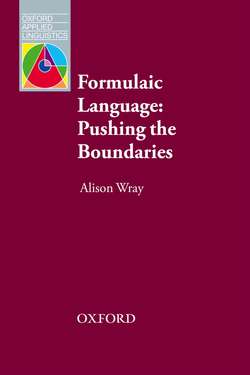Читать книгу Formulaic Language - Alison Wray - Страница 5
На сайте Литреса книга снята с продажи.
PART ONE
Determining boundaries
1
Introduction
At the boundaries
ОглавлениеHow does one engage at the boundaries? The answer is that one must take risks about what one examines. If one does not, one is not really at the boundaries at all. One must anticipate that at least some of the material one examines is possibly not formulaic – the point is to explore where the borderline is best placed. As in my previous publications, particularly Wray (2002b), my approach in this book is to err on the side of including too much in the first instance, rather than too little, on the assumption that it is better to examine and discard something than to overlook it.
Thus, in this book, the notion of formulaicity is extended to a range of linguistic and non-linguistic phenomena that may, for some, seem too extreme to really be counted as formulaic. They are included because they fall within, or very close to, the boundaries of the theoretical model arising from my 2002b account. The material explored here therefore encompasses not only idioms and common multiword strings with a specific communicative purpose, but also deliberately memorized phrases, extensive oral narratives, performance scripts, and even visual signalling systems. They have in common that a communicative act is effected using one or more internally complex, predetermined units of form. As the various data-based discussions throughout the book will reveal, lengthy memorized texts are evidently internalized as series of smaller chunks, at the boundaries of which variations may occur (see particularly Chapter 20). We might argue the toss, in such cases, about what the formula is: the smaller chunk or the larger script. And that is precisely the point of the exercise – to use a range of evidence and reasoning to come closer to a robust account of the essence of formulaicity.
Formulaic language is investigated here by looking at what happens when language operates beyond its normal scope, where there are unusual constraints on communication that make formulaic language more evident, or where language users choose, or are forced, to favour previously assembled output over something more spontaneous. In many different ways, we are at the boundaries – of language behaviour, of communicative potential, and of linguistic theory – and aim to see what happens when you squeeze a phenomenon until (as we say formulaically) the pips squeak.
